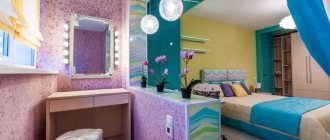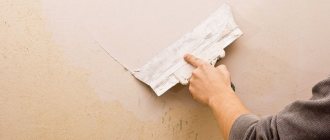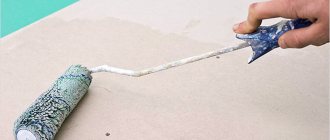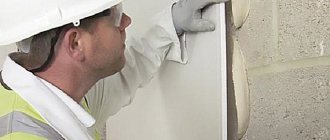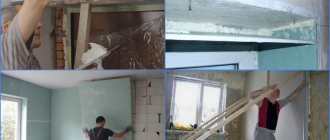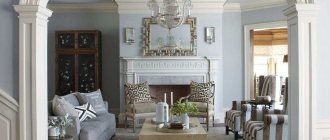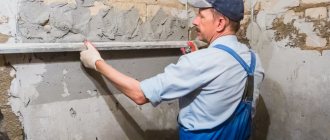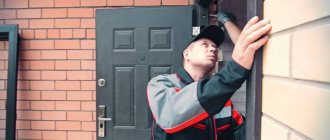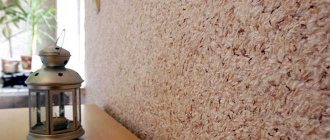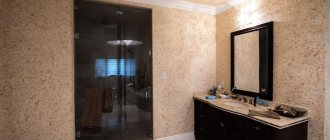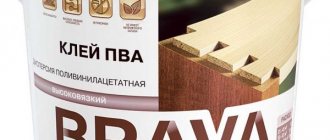Insulating an apartment allows you to significantly save on heating costs in the autumn-winter season. Most often, walls are insulated inside the apartment, and not outside. This is much more economical and does not require the services of professional workers and expensive materials for exterior finishing. For thermal insulation indoors, as a rule, structures made of metal profiles and plasterboard sheets are used. This method is easy and quick to install. Today you will learn how to independently install a plasterboard structure in an apartment.
How well does drywall retain heat?
Plasterboard sheets, among other advantages, have a low thermal conductivity coefficient. For this material it is 0.15, which is ten times lower than that of reinforced concrete. This allows you to significantly retain heat in the apartment and not let in cold air or summer heat.
Typically, to enhance the effect of wall insulation, additional materials are used that are placed between the main wall and the new structure. Polystyrene or foam plastic can be used for thermal insulation. These materials are easy to work with, but they are not often used in insulation. The main problem is that their effects on the human body have not been fully studied. In addition, they do not absorb sound well, and small rodents can damage them. Glass wool is used more often due to its budget cost and low thermal conductivity.
The disadvantage of the material is that it must be installed only with gloves. The composition of glass wool causes itching and irritation upon contact with the skin. Basalt wool is very similar to glass wool, but it is made from rocks of magnetic origin. One of the highest quality heat and sound insulating materials is isolon. It is sold in thin sheets, which allows you to not change the area of the room too much.
Designers' opinion
One can agree with the voiced thoughts of most modern designers about the use of material. This is a practical and really good option for interior decoration and the production of decorative elements. But when using drywall, you should start from its direct qualities and purpose, and use it strictly in order to increase practicality, and not install gypsum boards wherever you just want. It is also worth understanding that today there are a lot of other technologies and materials that may better meet the requirements of the process where the customer decided to use drywall. We solve structural problems with gypsum boards and use the material where it is needed. we exclude him as much as possible from projects that bring chaos, thanks to rash and impractical decisions!
Installation of gypsum board sheets
If working with drywall is new to you, you need to first familiarize yourself with some of its features. Before installing the guide profiles, a special tape is laid along the intended installation lines. It will serve as protection against contact with plaster. In this case, the drywall will be protected from the cold that comes from the metal profile.
Metal profiles are usually installed at a distance of 2 cm from the wall. It is recommended to install a frame made of galvanized profile. After installing the frame, insulation boards are placed behind it. The material must be inserted vertically. In no case should the edges of the insulation protrude beyond the front side of the profile.
The Importance of Latex Primers and Paratraders
Before decorating drywall, experts strongly recommended that you first apply a latex primer to the surface. Once you complete this step, allow sufficient time for the primer to dry.
If a vapor retarder is required then you should use foil or fiberglass protection. If, for example, a polyethylene para-retardant film is installed on ceilings behind the plasterboard, then it is important to install a protective ceiling sheath in front of the plasterboard. If loose-fill insulation is used, install the insulation immediately after the drywall.
By taking this advice, you can't eliminate all cold weather problems, but you should minimize them to the extent you can possibly control.
More on the topic:
- How to repair a plasterboard ceiling? Do you know how to repair a plasterboard ceiling? Cracks in drywall, whether on the ceiling...
- Installing, Sealing and Protecting Marble Tiles Marble floor tiles can be used in any area of the home, but are especially popular in the kitchen,…
- What is a capacitor unit? A capacitor installation is an electrical installation that is a group of several identical capacitors connected in parallel...
- Installation of access control systems at any facility A famous song encourages drivers to care about safety. A similar requirement applies to business, especially in the current...
Powered By
Step-by-step insulation with plasterboard (video)
When installing additional insulation, they should fit comfortably between the main wall and the plasterboard structure. To install rolled thermal insulation materials or better secure the slabs, it is recommended to glue them to the main wall or use special umbrella dowels. They differ from standard ones with a large cap.
To prevent moisture from accumulating in the insulation and losing its properties, it is covered with a special vapor barrier membrane. This material will be a barrier to warm air that leaves the room through sheets of drywall. Next, the plasterboard sheets are attached to the structure using self-tapping screws. Quite often, wooden rather than metal fasteners are used, because they have lower thermal conductivity. However, wood also has a disadvantage - it becomes deformed over time.
After installing the drywall, further finishing of the room is carried out. Following the processing of drywall, which we wrote about earlier, wallpaper, tiles, decorative stone or other finishing materials are glued to the walls.
Breaking the rules
A negligent attitude towards the process of saving products can be fraught with the following consequences:
- slab deformation;
- the appearance of cracks or chips;
- swelling due to excessive absorption of moisture, which will affect the quality of the material;
- change in color of the outer layer of cardboard.
All these points will lead to a decrease in the service life of the product, a complication of installation work, as well as a deterioration in the quality and properties of the material. All specified storage requirements apply to all types of slabs, even moisture-resistant ones. After all, with prolonged contact with moisture, they will lose their factory performance properties. Storing plasterboard sheets requires the buyer to comply with all conditions specified by the manufacturer. If these conditions are violated, the manufacturer is no longer responsible for his product. Therefore, it will not be possible to exchange it. Be responsible about storage and your repair will be of high quality and durable.
Drywall is a proven material that has earned a large number of positive reviews over many years of use. The scope of its application is huge and does not end with wall cladding or creating partitions. Not only professional builders, but most ordinary people are familiar with it firsthand. At the same time, few people know that drywall storage must be carried out according to certain rules, violation of which leads to deformation and damage to the material.
Full contents of the material
Insulation of an unheated room
Many novice builders are interested in the issue of installing gypsum board in an unheated room. We warn you right away: most professionals are against such installation. The fact is that even moisture-resistant material cannot withstand strong changes in temperature and humidity. If you decide to install plasterboard structures in such a room, but do not want to install additional thermal insulation, it is enough to attach the sheets to a frame made of metal profiles. The air between the structure and the main wall will provide some thermal insulation.
It is possible to insulate an unheated room, such as a loggia or balcony, only under certain conditions. Firstly, it must be glazed. We are not talking about simple wooden frames, but at least double-glazed windows. They provide reliable protection from moisture and cold. In addition to the walls, you will need to insulate the floor and ceiling, which are covered with high-quality moisture-resistant plasterboard.
GCR can be used in loggias that are connected to a living room with a normal microclimate. Think carefully before you start installing drywall in such rooms, because the structure “eats up” at least 6-7 cm of space. Thermal insulation in the loggia is carried out in the same way as in ordinary rooms, but with some features. First, the wall is covered with waterproofing material.
Improper storage and transportation features
The consequences of improper storage can be disastrous. Impaired air exchange in the room inevitably leads to increased humidity. Its increase to 85–90% promotes the formation of mold or condensation, which destroys the top paper layer of drywall. Not using plastic film leads to a similar effect. Dirt accumulates on the surface of the material, it becomes unprotected from external influences and moisture.
Neglecting installation rules leads to problems of a different nature.
Placing gypsum boards on the floor without creating a support makes them unprotected from possible ingress of water, and also significantly reduces the quality of ventilation of the lower sheets. The absence of the necessary 3–4 points of support leads to deformation and sagging of the surface, which is due to low longitudinal stability and the high weight of the material.
Transporting drywall is a potentially dangerous undertaking. The large surface area and its fragility often cause material damage. Loading and transporting sheets must follow the following rules:
- Transporting several sheets of drywall is carried out exclusively flat using a trolley.
- When loading into a car, special attention is paid to the edges, which easily crumble from the slightest impact.
- A special platform with 4–5 support points is installed in the body of the car, on which the material is placed (carrying it in a vertical position is strictly prohibited).
- Plasterboard sheets are stacked one on top of the other and carefully aligned relative to each other.
Transporting drywall indoors
To transport a batch of drywall up to 25–30 units, such standards are more than enough. If you follow them, you can be sure that the material will reach the final point intact and safe. At the same time, at the time of unloading and bringing it to the site, you must be extremely careful, and having delivered it to the site, you should organize all the conditions for its high-quality storage.
conclusions
If you approach wall insulation responsibly, you can create an atmosphere of comfort in any apartment. We hope that our simple instructions will help you implement this plan. Good luck.
It is not easy to make thermal insulation of a multi-storey building; special equipment is required. But insulating the walls inside with mineral wool or plasterboard gives a good effect. With proper installation, heat loss is reduced by 20-30%. The main thing is that the thermal insulation layer in the room corresponds to the technology. We will tell you in this article how to properly insulate walls from the inside of a living room with plasterboard.
Other publications in the “Interior decoration of the house” section
As we know from practice, renovating an apartment or house is an interesting, educational, and sometimes even eternal process. Therefore, many homeowners prefer to do repairs on their own. Of course, there are those who do their own repairs simply because they don’t have enough.
What are the risks of using conventional slabs in the bathroom? Let's consider the features of constructing partitions in the bathroom from tongue-and-groove gypsum boards. Each such slab is made of building gypsum and is a rectangular parallelepiped, the joining and supporting surfaces of which are .
The house is made of adobe, walls without lathing, sand-clay plaster, lime whitewash. How to properly approach the issue of leveling walls with putty (finishing) or how to properly prepare such walls for painting with water-based paint. Thanks for the answer Answer: If the house is old enough and there are .
«>
Types of drywall and its use
Drywall can be used to insulate walls inside a building. Use either moisture resistant or wall.
Moisture-resistant can be used in dachas or for rooms with a high degree of humidity: bathrooms and kitchens.
Important! Moisture-resistant plasterboard, the best solution for rooms where heating is not provided.
This material is not at risk of cyclical temperature fluctuations. After installing the sheets, you only need to apply a waterproof primer or protective paint to the front part. You should also treat drywall with an antiseptic to kill harmful germs and bacteria.
Material selection criteria
In addition to the presence or absence of a heating system, when choosing decorative finishes, it is necessary to take into account the base material of the walls. The most suitable solutions for finishing a country house for seasonal use are recommended:
For enthusiastic and dynamic people, it is better to choose a finishing method that allows you to easily change the finish layer. For such owners, it would be more correct to choose plaster or gypsum plasterboard sheets as the interior decoration of the walls at the dacha. For a perennial option, it is better to choose a finish with a soft texture and color.
Types of insulation
It is better to insulate the surface under drywall using mineral wool or polystyrene foam. You can also use isolon or penoplex. These insulators differ in installation methods, cost, and strength.
According to research, polystyrene foam, like polystyrene, is harmful to health. It is rarely used in residential premises. Another disadvantage is that some types of foam are eaten by rodents. But it has a low cost and is also available in many densities and sizes.
Example of insulation with plasterboard and mineral wool
As for mineral wool, the advantages include low weight (especially important for insulating old buildings), as well as low thermal conductivity. There is only one significant disadvantage of mineral wool - hygroscopicity. Therefore, when thermally insulating partitions and walls, it is necessary to prevent the accumulation of condensation. For this purpose, vapor insulation should be used.
There are several types of mineral wool. They all differ in the production method, composition and technical indicators. Among the types of wool that are on the market, the most popular is fiberglass-based basalt wool. Like other types of insulation, they have both advantages and disadvantages.
The main negative aspects of glass wool:
- The thermal conductivity indicator is greater than that of stone, and therefore heat disappears faster.
- At elevated temperatures it forms a solid glass mass.
- Inconvenient to work with (glass wool fibers can cause itching; requires the use of protective glasses, gloves, a respirator, and wearing a thick suit).
Important! For greater efficiency, it is necessary to lay mineral wool in 2-3 layers.
Despite their external similarity, basalt and glass wool are significantly different. Glass wool is made from very thin glass fibers, and basalt wool is made from volcanic rock. They also differ in the indicator of thermal conductivity, which is lower in basalt, and, therefore, it retains heat better.
Cost of materials for insulation:
- The cheapest way would be to insulate the walls of the house with polystyrene foam, the price of which ranges from 70-90 rubles. for 1 sq. m.
- As for mineral wool, it costs a little more - 90-150 rubles. The price of the material depends on its density, thickness and manufacturer.
- Penoplex, which is extruded foam plastic, but with increased strength and density, costs 1 sq. meter approximately 200 rubles.
Isolon (foamed polyethylene) can also serve as an insulator. Its cost will be 280-300 rubles per 1 square meter.
Dropping temperatures can cause problems
Before you begin a drywall installation project, it is important to plan ahead.
For one, understand that cold weather and wintry conditions can affect the performance and behavior of your drywall panel and walls in a variety of ways. However, if you don't want to face problems, you can take steps to stop them before they start. Use drywall installation tips - on interior walls, partitions and ceilings - to get the finished product the way it should be, and in a way that reduces problems in the project.
Stages of thermal insulation of a wall
In order for the work process to proceed quickly and properly, you should prepare the necessary tools. This will significantly speed up the work on protecting the walls with insulation.
The following materials will be required:
- plasterboard sheets;
- self-adhesive tape;
- insulation;
- membrane to ensure maximum vapor barrier;
- screws, nails;
- hammer, screwdriver, hacksaw;
- yardstick;
- metal profiles or wooden slats for constructing the frame;
- fastening materials.
For 1 sheet you need approximately 30 pieces of self-tapping screws. It is best to buy screws 20 mm long.
As for the manufacture of the frame, the profile must be taken of 2 types: marked CD and UD. The length is selected based on the size of the room.
Frame design
It consists of drawing the perimeter and thinking through how the frame will be positioned on the wall. A simple pencil and a building level are enough.
Advice! For the best insulator effect, the structure must be positioned 3-10 cm from the wall.
- surface cleaning;
- smooth out all the unevenness and fill up the cracks and depressions;
- drying with a heater or blow dryer;
- getting rid of mold and mildew.
Sometimes it is necessary to treat the walls with a special waterproofing putty to prevent the occurrence of dampness. First, the layer is applied vertically, then horizontally.
Frame construction
According to pre-made marks, you need to mount the frame. To avoid contact of the metal structure with the wall, a tape prepared in advance is glued to the base of the profile. The frame parts are fastened to the wall using self-tapping screws and dowels.
Before laying the insulator, the surface is prepared in advance. Weak areas of plaster are removed or restored. To eliminate the possibility of the formation of fungus and mold, it is necessary to treat with a primer and an antiseptic.
Sheets of plasterboard are installed on a frame made of metal or wood. A metal frame will last significantly longer than one made of timber.
In the area where batteries are located, where installing thermal insulation is difficult, penofol can be used.
You can make a frame from bars under drywall
Assembling the frame begins with the installation of guides created from the UD profile. The slats are mounted on the ceiling and floor with a distance of 50-60 mm from the walls. A section of the rack profile is inserted into the guides. The ends are fixed using small self-tapping screws (“fleas”). The edges of the hangers are folded from the sides and connected to the slats. The pitch between the profiles must be observed so that there are 3-4 slats per sheet.
Important! When the frame is constructed, they begin to lay the insulator.
To improve the rigidity of the structure, it is necessary to make transverse bridges from the CD profile. The profile is cut so that its length overlaps the adjacent slats by half. Use metal scissors to cut off the shelves. Then the blanks are fixed with fleas onto the frame.
The main purpose of drywall
- There are several main manufacturers on the market - Knauf, Gyproc, Rigips and others;
- Drywall, different types and areas of work: GKL - standard, GKLV - moisture-resistant, GKLO - fire-resistant, GKLVO - moisture-fire-resistant, GVL - gypsum fiber sheet;
- Material by type of edge - straight, semicircular, rounded, thinned and others, combined;
- Drywall by type of work and purpose - wall, ceiling, arch!
Such a classification is necessary for the purchase of material, as are the dimensions of the sheet, its thickness, and accurate calculations of the area. But, first of all, you should understand the purpose of the material, where it can be used in rough or fine finishing, the production of architecture, and decorative compositions for interior design:
- The main direction is the production of wall structures and partitions. Drywall is used to construct lightweight frame walls for space planning;
- The next task for gypsum boards is leveling surfaces as an alternative to plaster. You can work with walls and ceilings, architectural structures, partitions. Drywall is installed on an adhesive base, wooden or steel frame;
- Drywall is an excellent material for filling niches and producing communication boxes. Under it and behind it you can hide any pipes and wires, highways and channels - water supply, ventilation ducts, etc.;
- And finally, gypsum plasterboard is popular in the production of suspended ceiling systems, classic and multi-level combined. The material can be used for standard ceiling leveling, but also serve as one of the elements of a modern combined ceiling made of gypsum plasterboard and wood, gypsum plasterboard and glass or mirrors, gypsum board and stretch ceiling!
These are the main areas of application where gypsum boards can be used to reduce pressure on the budget and increase the speed of work. Their quality does not depend on the material itself, but on a complex that combines the correct choice of gypsum boards and fastening systems, compliance with technology requirements, and compliance of the material with the assigned tasks!
Despite its main purpose, today drywall is used to solve the following problems:
- Creation of standard and curved arches for zoning rooms, as well as designing doorways;
- Production of storage systems in hallways and pantries, in the kitchen and living room. Difficult operating conditions should be avoided, as well as the production of open thin shelves;
- Production of through partitions and cabinets, special wall niches for placing equipment and equipment;
- Production of significant interior design items - false fireplaces, 3D figures, decorative lighting systems;
- Special overhead decorative items for walls and ceilings, design elements for built-in cornices;
- Bar counters, children's play complexes, special structures for pets, wall panels, screens for wide window sills and bathtubs, etc.!
Insulation of balcony walls
As for the insulation of balconies and loggias, such structures require compliance with certain rules.
The material for thermal insulation must be:
- waterproof (since there is a high probability of water appearing on the balcony);
- you need to buy only moisture-resistant drywall;
- walls should be treated with an antiseptic.
To insulate balconies, a frameless method is often used. This is due to the fact that such a space has a small area. The insulator creates a higher degree of structural reliability, despite various influences: tension, humidity and other loads.
Initially, the walls are prepared for fastening the sheets. All fragile areas are restored, and the surface is treated with an antiseptic substance.
As soon as the walls are prepared, the installation of sheets begins. Initially, they need to be cut into the necessary pieces. It is not recommended to cut sheets right away; it is better to do this as you work.
Once the material is prepared, you can begin fixing it. This should be done using an adhesive composition. This is the easiest way to attach gypsum boards. When carrying out such work, you need to ensure that the layer of the mixture is the same everywhere.
Thermal insulation allows you to protect the house from dampness, drafts and provide a favorable and comfortable microclimate. After all, with insulation, like a shield, you can isolate yourself from the harmful influence of the environment.
With the help of room insulation, you can protect your home from dampness, drafts and create a pleasant microclimate. After all, insulation, like a shield, manages to isolate itself from the adverse effects of the external environment.
One of the best ways to save heat is to insulate the walls from the inside with plasterboard.
Drywall is a material that has undeniable advantages over other finishing methods. It is very convenient to use, and the thermal insulation is inexpensive and beautiful.
What thermal conductivity coefficient does drywall have? Thermal conductivity usually refers to the ability of a substance to transfer heat to the coldest areas from the hottest areas. Materials with lower values retain more heat. Drywall has a thermal conductivity value of 0.14 - 0.15. For example, reinforced concrete (the most common partitions in houses) has a high value - at least 1.5. And for various types of insulation, this figure is five to six times lower than for drywall.
Wall insulation under plasterboard is often used both in large office premises and in ordinary apartments, especially corner ones, when external insulation is problematic or expensive.
Which is better and correct.
In the article, how best to store drywall,
Naturally, we will talk about the safety of drywall from external factors, moisture and the position in which drywall should be located at a construction site. We’ll also discuss where it’s best to store drywall when you’re not using it. The material on how best and where to properly store drywall will be supported by photos and videos on the topic.
On the pages of the site “Construction from A to Z. Enakievo-Donetsk” we have discussed a lot about gypsum craton. The very first topic was what plasterboard is made from*, after which we talked about plasterboard ceilings*, about installing plasterboard with glue*, discussed the construction profile* that holds the plasterboard itself and looked at the types of fasteners* for plasterboard, and the profile subsystem of plasterboard. We even found out what kind of drywall there is*. Well, now, in my opinion, it’s time to talk about storing drywall at a construction site.
How to store drywall at a construction site.
In my opinion, not having enough space, drywall at a construction site in order to save useful space and avoid knocking down corners, drywall in an apartment is, of course, better to store it sideways under the wall, simply leaning it vertically on the wall, according to the longest side in length, as shown in the photo on the left.
To prevent the drywall from being deformed in this position, it is better to place the nearest sheet that is adjacent to the wall at a slight angle, and simply place the remaining sheets of drywall against it.
Drywall sheets can be placed simply on the floor
, but in order to avoid any situations, it is worth placing a stick or a wide board under the bottom, which will ensure that in case of a leak, something spilled, it will not get on the drywall and it will remain intact and safe.
It is better to cover neatly folded drywall under the wall with polyethylene or construction film, which is freely available at any hardware store. Covering the top of the drywall with film will allow you to protect the sheets from such factors as: excessive clogging of the sheets with dust, again, the film will prevent the ingress of water, paint, and partially protect from mechanical damage. It is in this position under the wall, on a stand, covered with film, that it is better to store drywall.
Advice on the topic: If you store drywall on its edge, then you don’t have to lift it from the floor! Also remember that drywall cannot be stored in a standing position at height. In this position, it will simply bend under its own weight.
If you have the option of storing drywall at a construction site lying down, then you should adhere to the same rules: put it on a backing, cover it with film. In any case, no matter in what position the drywall is stored and is not on site for a long time, to a greater extent, the first and last sheet will have to be cut or dissolved into pieces, since these two sheets will not be suitable for further full-scale work.
What humidity and air temperature should be in the room when storing drywall?
Regarding the air temperature and humidity in the room when storing drywall, there are constant discussions and no one will come to the same conclusion. In fact, it is not fussy during storage, but during installation, its humidity matters. The installation* fits tightly into dry drywall and holds it perfectly. The paper on the drywall does not break through and the gypsum itself is quite dense. But if the drywall was stored in a damp room, then when installing it on the walls or ceiling, problems with fixation will arise. The screws will dangle from side to side due to the fact that the plaster will be damp and will not be able to hold the screw in the correct direction, and the paper on the drywall, when pressed with the head of the screw, will easily break through.
If we get closer to the point, the temperature in the room does not have any effect on the drywall! But the air humidity during storage and work with it, according to GOST*, should be:
- In winter 25-30%;
- In summer, 40-45%, but no more.
Which drywall is best to use?
The length and width of all sheets are standard (length 2.5 m -3 m, width 1.2 m). In terms of thickness for walls, you need to take sheets of 12.5 mm (9.5 mm is ceiling plasterboard). But the type will need to be determined depending on the room and functions. There are:
- standard;
- moisture resistant;
- increased strength;
- windproof and waterproof;
- fire resistant;
- types of material.
There are three methods of insulation using this technology:
- adhesive method of attaching gypsum boards directly to the wall;
You can fix the drywall directly to the wall with gypsum or cement-polymer glue. Perlfilks from Knauf is used as gypsum glue. With this type of finishing, the area of the room is not reduced, and sound insulation appears - this is an advantage. The disadvantage is that you cannot install thermal insulation and the walls must be strong. Insulating under drywall in this way produces very little heat and is therefore not recommended.
frame method, without further laying of any insulation;
Plasterboard sheets are mounted on a frame made of metal profiles or wood. A metal frame will last much longer than timber slats. Wood can dry out and become deformed, especially in the event of sudden temperature changes. When using this method, everything is simple - even without installing additional insulation, the layer of air between the wall and the plasterboard sheets provides thermal insulation.
frame method with insulation
Here, the distance between the mounted drywall and the wall surface must necessarily be equal to the thickness of the insulation. The distance between the vertical beams and the frame profiles is usually half the width of the plasterboard sheet. As a rule, one layer of insulation is sufficient. In the area of batteries where installation of thermal insulation is difficult, penofol can be used.
Where and how is it recommended to store plasterboard sheets
The acquisition and storage of building materials for interior finishing work is a very important and responsible moment. Particular attention in this situation is occupied by the storage of drywall (gypsum board).
Knowing the storage rules will help you avoid damage to your products.
Storage rules
Any gypsum plasterboard manufacturer must include recommendations with the product regarding what storage conditions and rules must be followed by the buyer so as not to damage the material. However, not all sellers treat this issue responsibly. Therefore, if you are planning to do renovations using drywall, you need to know the basic rules for storing it indoors.
For gypsum boards there are the following storage rules:
In addition, there are requirements for the placement of the material itself:
Note! The minimum distance to batteries should be 1.5 m.
By following these rules, the purchased building material will remain in perfect condition until installation work begins. There are several ways to place drywall in a room suitable for the parameters. Bundles of material can be stored either horizontally or vertically.
The easiest way to place gypsum board packs is “lying”, i.e. in the plane of the floor. To avoid damage and deformation of the slabs, a certain structure made of boards should be built under them, or special pallets can be used.
Storage base
This design will help prevent product damage if moisture gets on the floor. The rise of the pack above the floor level should be approximately 10-20 cm.
If you have problems with space in the room, then the best way to place it is to lean the pack on the wall (put it “on its edge”).
But in this situation, it should be remembered that in order to prevent deformation changes in the slabs, we place the first sheet from the package in such a way that it is as close as possible to 90 degrees. Those. it should be almost parallel to the wall.
Note! Under no circumstances should sheets be placed “edge-on” with their narrow side. This position of the plates will lead to inevitable deformation under its own weight.
We place the remaining sheets close to it. This way they will be positioned vertically.
No matter how you decide to place the drywall, it must be covered with film. For vertical placement this is especially important. The film will protect the product from excessive contamination with dust, prevent moisture from entering from above, and also eliminate the possibility of damage from mechanical impacts of small forces.
Outdoors
In rare cases, it is allowed to place plasterboard sheets before installation work begins on the street. But there are certain restrictions here. These include:
This method of saving is used only in extremely rare situations and with the obligatory adherence to all the above recommendations.
What insulation to use
To prevent convection air flows and increase the thermal resistance of the walls, the frame cells are filled with thermal insulation material.
The most common types of insulation used as insulation under plasterboard sheets:
- Styrofoam. Now they often write about its dangers (along with polystyrene) for health. It is rarely used in residential premises. The second disadvantage is that rodents eat it. But this type of material is cheap and available in many sizes and densities.
- Stone wool. The advantages of mineral wool include lightness (especially important for insulating old buildings), as well as low thermal conductivity. The air layer that appears between the mineral fibers turns this material into a kind of thermos. There is only one significant drawback of mineral wool - hygroscopicity. Therefore, when thermally insulating the walls of premises from the inside, it is necessary to prevent the accumulation of condensate and provide a vapor barrier.
- Glass wool. Made from thin glass fibers. Has a number of disadvantages:
Advantages and disadvantages
The undoubted advantage of insulation under plasterboard is the geometrically ideal surface of the walls and fairly high thermal insulation efficiency. The disadvantage is that the thickness of the frame for attaching drywall “eats up” part of the area of the room, which is very important or simply unacceptable for a small room. It should also be noted that plasterboard has a low load-bearing capacity: heavy shelves and other interior elements cannot be hung on it. This problem can be solved by installing additional vertical frame profiles or anchors attached to the wall through sheets of drywall.
Another inconvenience of use is the fact that drywall is not characterized by mechanical strength. If hit, it may break. Untreated sheets, when subjected to force, emit dust that negatively affects the human condition.
Ideal temperatures for your project
Knowing what temperatures are ideal before starting your project, or phases of it, can help you avoid some of the headaches that can come with building in cold weather. For example, interior temperatures should not be cooler than 50 degrees for at least two days before threading and finishing.
This will allow the drywall to dry completely.
If different methods or additional texturing are required, do not apply them until the previous coat is completely dry. For mechanical installation of drywall, the room temperature must be at least 40 degrees.
If you are mixing materials that will be applied to drywall, you must have a consistent temperature of no colder than 50 degrees for two days, from starting the mixture until applying the product and drying. If the temperature drops below this time, this part of the project should be postponed until you are working in the correct temperature conditions.
Wall thermal insulation technology
Insulating walls with plasterboard is very widespread, so the technology is well established. Carrying out work with drywall on your own is quite problematic; you will need a second person, as well as certain skills and, of course, special tools. But if you wish, if you prepare everything correctly and call an assistant, you can do the work yourself.
1. Procurement of tools and materials
- the drywall itself;
- materials for the frame (metal or wooden slats);
- insulation;
- self-adhesive tape;
- fasteners (screws and dowels);
- vapor barrier film;
- putty;
- antifungal liquid
2. Preparing the walls
The process includes:
- surface cleaning;
- putty of cracks;
- drying with a hair dryer or heater;
- removing traces of mold and mildew;
- It may be necessary to treat the walls with a special waterproofing putty to prevent possible dampness. In this case, the first layer is applied vertically, the second horizontally.
3. Marking walls for frame assembly
This is done using a level and plumb line.
4. Frame installation
Still, a metal frame is more technologically advanced than a wooden one. Self-adhesive tape is glued to the profile attached to the floor, which improves sound insulation.
5. Fastening the insulation
The thermal insulation layer is attached tightly, without gaps. You can glue it to the wall with special glue or use the “umbrellas” used to attach foam plastic.
6. Vapor barrier device
If penofol is used, you need to make sure that the foil side of the material is facing inside the room.
If the insulation of walls under plasterboard is provided with a vapor barrier material with a rough surface, then the uneven side should face inward. It serves to trap moisture with its further retention on the fleecy surface. By ventilating the structure, excess liquid is removed.
7. Installing drywall
8. Processing of joints
Putty is applied to the joints of plasterboard sheets, reinforced with a special plaster mesh - “serpyanka”. If several layers are applied, you need to wait until the previous layer dries.
9. Decorative finishing. Painting or wallpapering
Finishing with natural materials
There are many options for finishing brick or foam block walls and the inside of a wooden house. Modern technological finishing materials offer various cladding options, for example, wood wallpaper, which is made from natural wood. They are applied to the walls of the cottage indoors using a special adhesive solution. The main and very significant disadvantage is their cost.
A less expensive method would be to decorate the interior walls of a house with block-house material. Before installing the slabs, allow them to rest indoors at room temperature for 48 hours. The material is mounted on flat walls, on pre-stuffed wooden frame beams.
Fiberboard will be an inexpensive finishing material
The elements are screwed to the guides with self-tapping screws through the base of the tenon, which all boards are equipped with. The elements are connected to each other using a groove-tenon system. To give additional external gloss, upon completion of the work, the surface can be coated with varnish, wax or stain.
Lining is one of the easiest materials to work with, a way to inexpensively cover the walls of a country house with your own hands. This results in a completely environmentally friendly and clean finish. The lining is mounted by stuffing slats onto horizontal guides, fixed at a distance of 0.5 - 0.7 m from each other. For more information about how and how to decorate a country house, watch this video:
The wood must first be treated with antiseptic and fire-retardant compounds.
Thermal insulation of walls in damp and unheated rooms
In such cases, moisture-resistant plasterboard is used. It's more expensive than usual, but don't skimp! Wall cladding with such material is carried out both in rooms where humidity is high, and in very wet ones. Already at the production stage, the ability to withstand moisture is established - plasterboard sheets are subjected to special heat treatment, which helps prevent the appearance of mold and fungi.
The product is pigmented with green dyes to distinguish it from sheets of other types. Special water-repellent and antifungal additives enable this material to retain its unique characteristics even at high humidity. This does not eliminate the need to combat humidity in the bathroom. Such a room must have forced ventilation. It should not be tied to turning the lighting off/on. It is advisable to use a humidity sensor in the electric fan control system.
Moisture-resistant drywall is recommended for use where there is no constant heating. For example, at the dacha. It is able to withstand cyclical temperature changes. It is only necessary after installing the sheets in rooms that are not heated to apply a waterproof primer or protective paint to the front side. It is also recommended to treat drywall with an antiseptic that contains components to destroy harmful microorganisms.
Thermal insulation of walls using plasterboard has a significant advantage over other methods. This is a great way to insulate walls and, at the same time, reduce noise levels in a house or apartment. This indicator is of particular importance if the house is located on a large street, with tram lines or a railway running nearby.
Is it worth using drywall for finishing?
Today, the basis for satisfying the information appetite is the Internet. It’s hard to argue with this, because if we need an answer to any question, we turn to Google and Yandex via a PC, tablet or smartphone, rather than going to the library. But here, in the fields of the electronic network, there are many pros and cons, myths and legends. But there are also truthful conclusions. It is with them, against the backdrop of a huge flow of information, that we need to understand if we need to study materials for the architecture and decoration of our own home. Next up is drywall - a popular and sought-after material that is practical and, one might say, somewhat universal. I will tell you in this article whether it is possible and whether it is necessary to use drywall in your own home!
Author: Alexander Kirichenko
Contents of the article:
There have always been disputes on the topic of this material. And their main participants are specialists in our specialized field: designers, builders, decorators, finishing specialists, and directly, the customers themselves. There are not even hundreds of opinions, but thousands and tens of thousands, so you need to sort out the issue, taking into account the recommendations of drywall manufacturers, the features of production and installation technology, building codes, and technical characteristics of gypsum boards!

